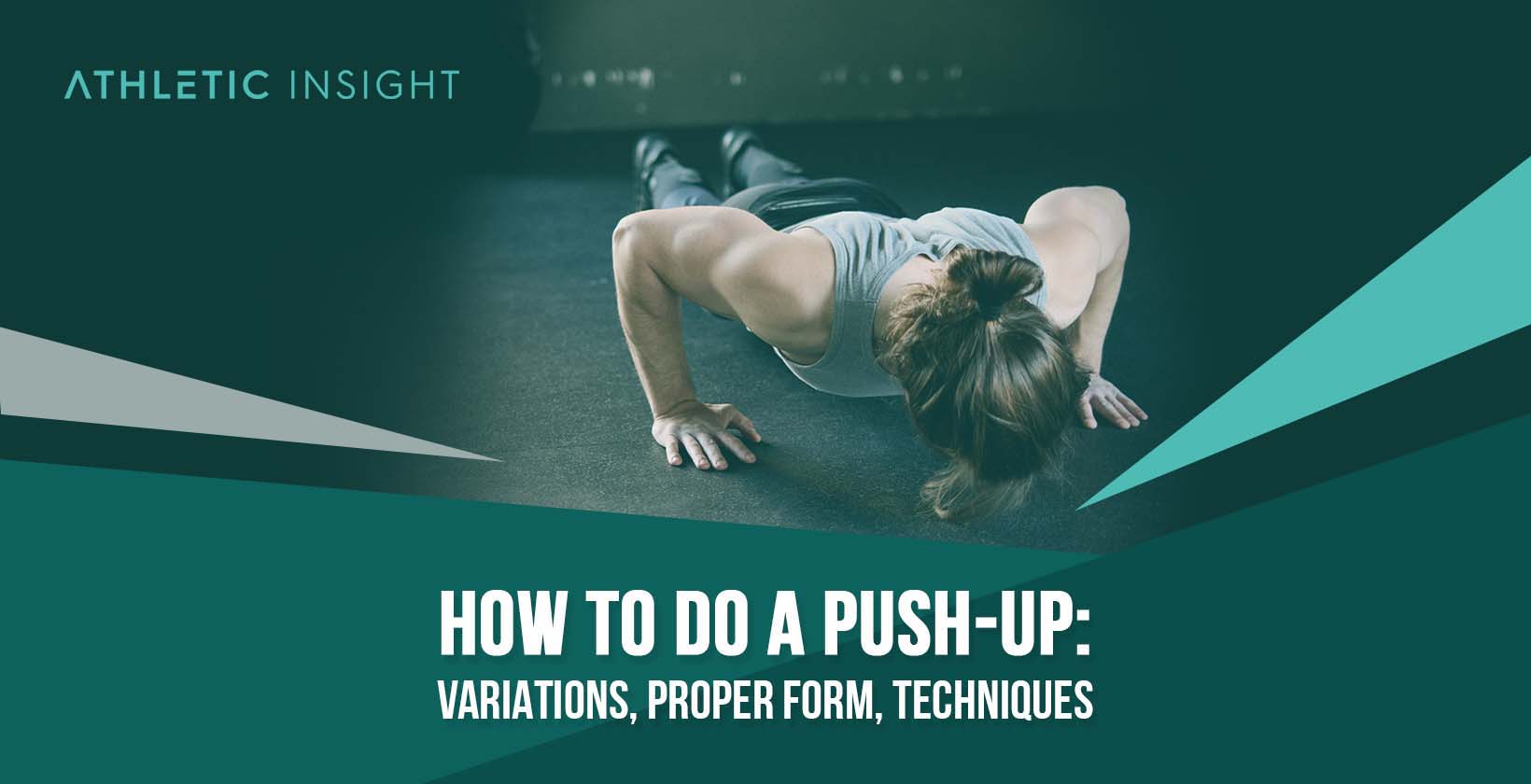A push-up is a bodyweight exercise that consists of raising and lowering one’s body weight against the floor using the arms. This calisthenics exercise targets the pectorals (chest), deltoids (shoulders), serratus anterior (fan-shaped muscle behind your armpits), and the triceps.
There are many health benefits to performing push-ups. This exercise increases your core strength, upper-body strength, arm strength, back strength, and can even improve grip strength.
There are many variations of push-ups and push-up techniques, all with benefits and risks. Some are beginner-friendly while other variations are only recommended for advanced athletes. To name a few variations, an individual performing a push-up can use an incline or decline, add resistance (or weight), and even reduce the movement to a single-arm for further isolation.
While push-ups are highly beneficial and healthy for the body, there is information that one should know before adding this exercise to their daily or weekly regimen. It’s essential to understand proper form and technique to gain maximum benefits from push-ups. Failure to do so may lead to joint pain and even muscle tears.
How to Perform Push-up with Proper Form?
To perform push-ups properly, one must have the correct form. This is important so that the muscles get exercised correctly. Proper form ensures that one receives the full benefits of the push-ups and does not do any accidental harm to their body.

Proper form refers to the correct way to perform an exercise. There is the right way to do each exercise so that the movement only uses the targeted muscles. As the body fatigues, it will attempt to transfer the effort and energy to secondary muscle groups.
Proper form avoids this and ensures that the intended muscles get exercised. This helps to prevent injuries and unnecessary strain on the body. It’s essential to use proper form when performing a push-up so that you do not cause injury to the muscles and so you maximize the strength training achievements gained from this exercise.
The proper form for push-ups is as follows.
- Get into an upward position, hands on the floor and shoulder width apart.
- Keep abs tight and your whole body in a straight line.
- Keep your neck relaxed and head neutral.
- Lower your body slowly to the ground
- Pause for a second before pressing off of the floor back to the starting position.
1. Get into an upward position, hands on the floor and shoulder width apart
This is crucial to maintaining proper form during push-ups. Hold your muscles tight to engage your shoulders, hips, and core. Squeeze your glutes (butt muscles) and your quads (thigh muscles). Pulling your belly button towards your spine will keep your core (abdominal muscles) tight and ensure that you are working them out properly.
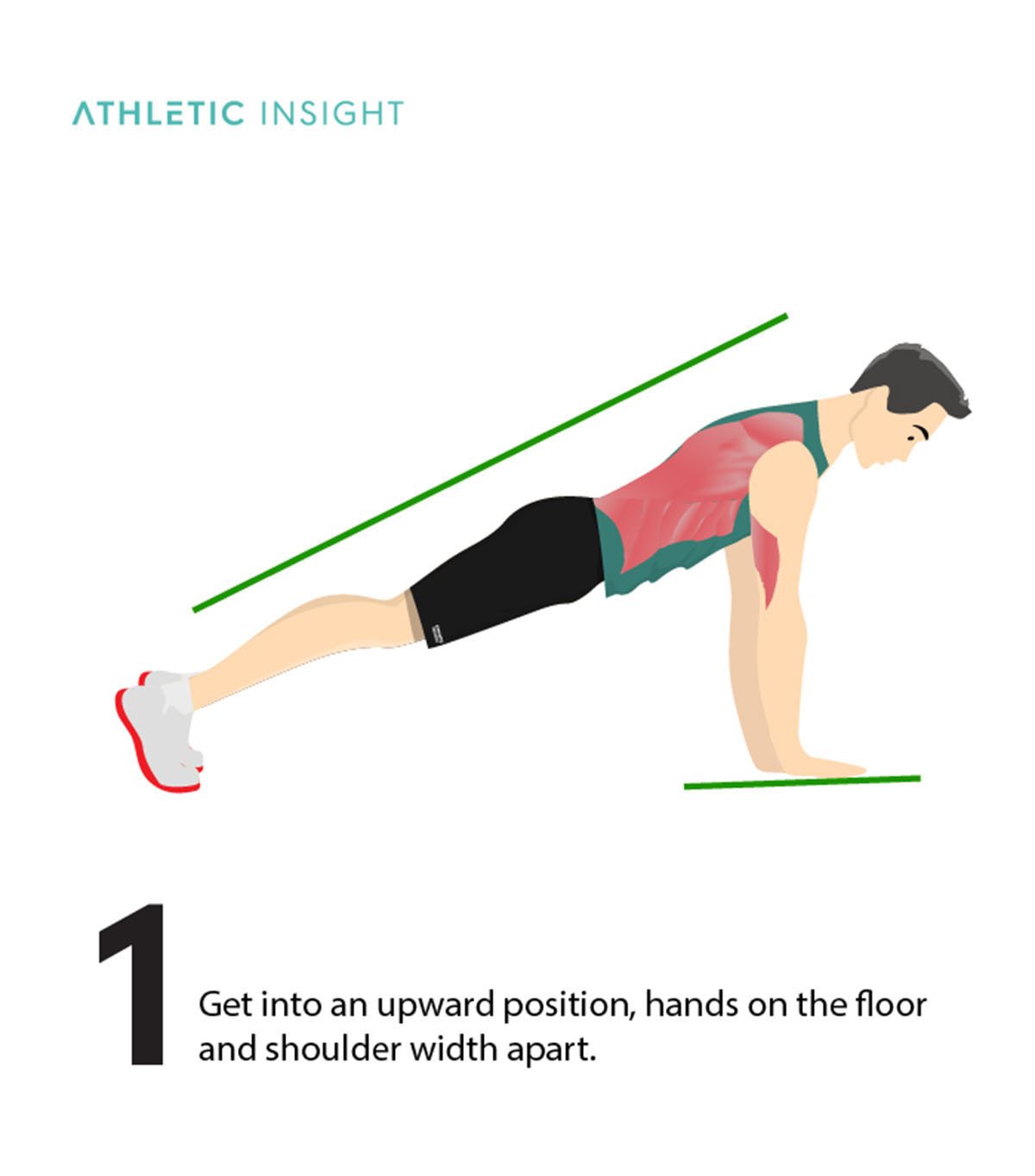
2. Keep abs tight and your whole body in a straight line
You will be on all-fours. Your legs should be extended hip-width apart. You can start with your knees on the floor if it is more comfortable and then slowly straighten your legs to lift yourself into the plank position.
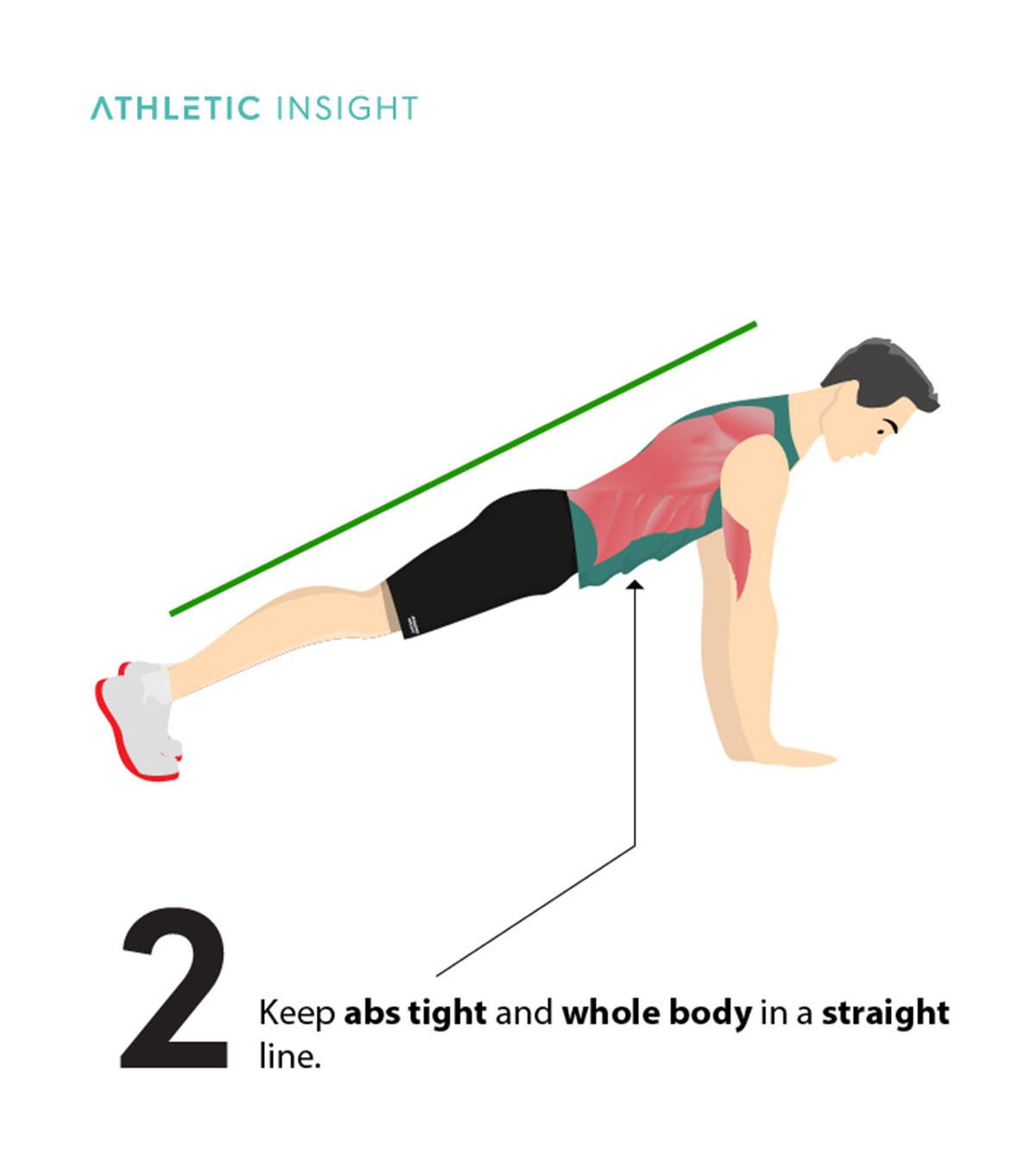
3. Keep your neck relaxed and head neutral
Be sure to hold your body at a 90-degree angle with your neck relaxed and the head in a neutral position.
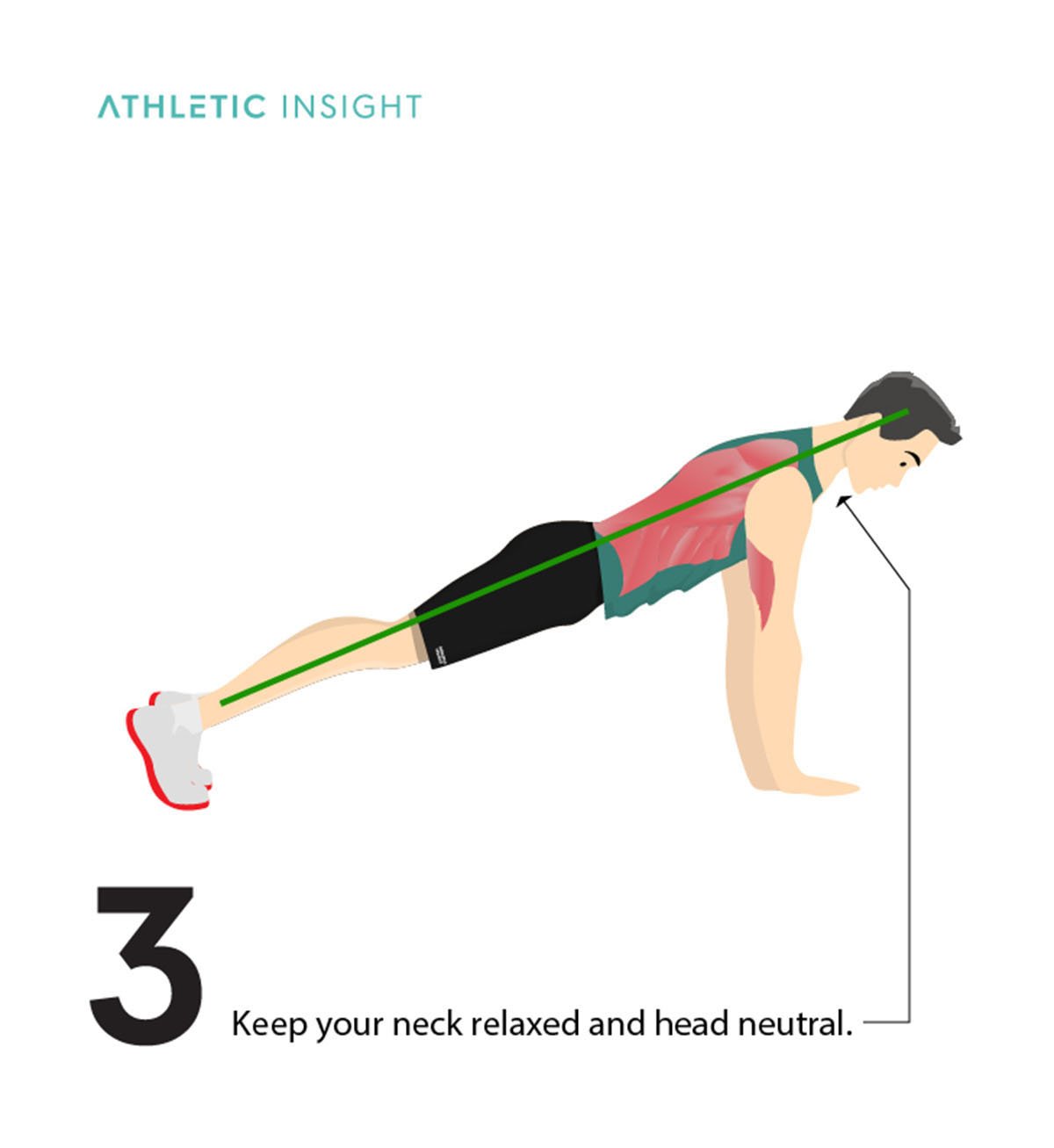
4. Lower your body slowly to the ground
Your chest will move towards your hands as your elbows bend, and you will feel your shoulder blades retract. Your body will lower towards the ground. Make sure that you breathe in during this step. Pause at the bottom for maximum physical effect.
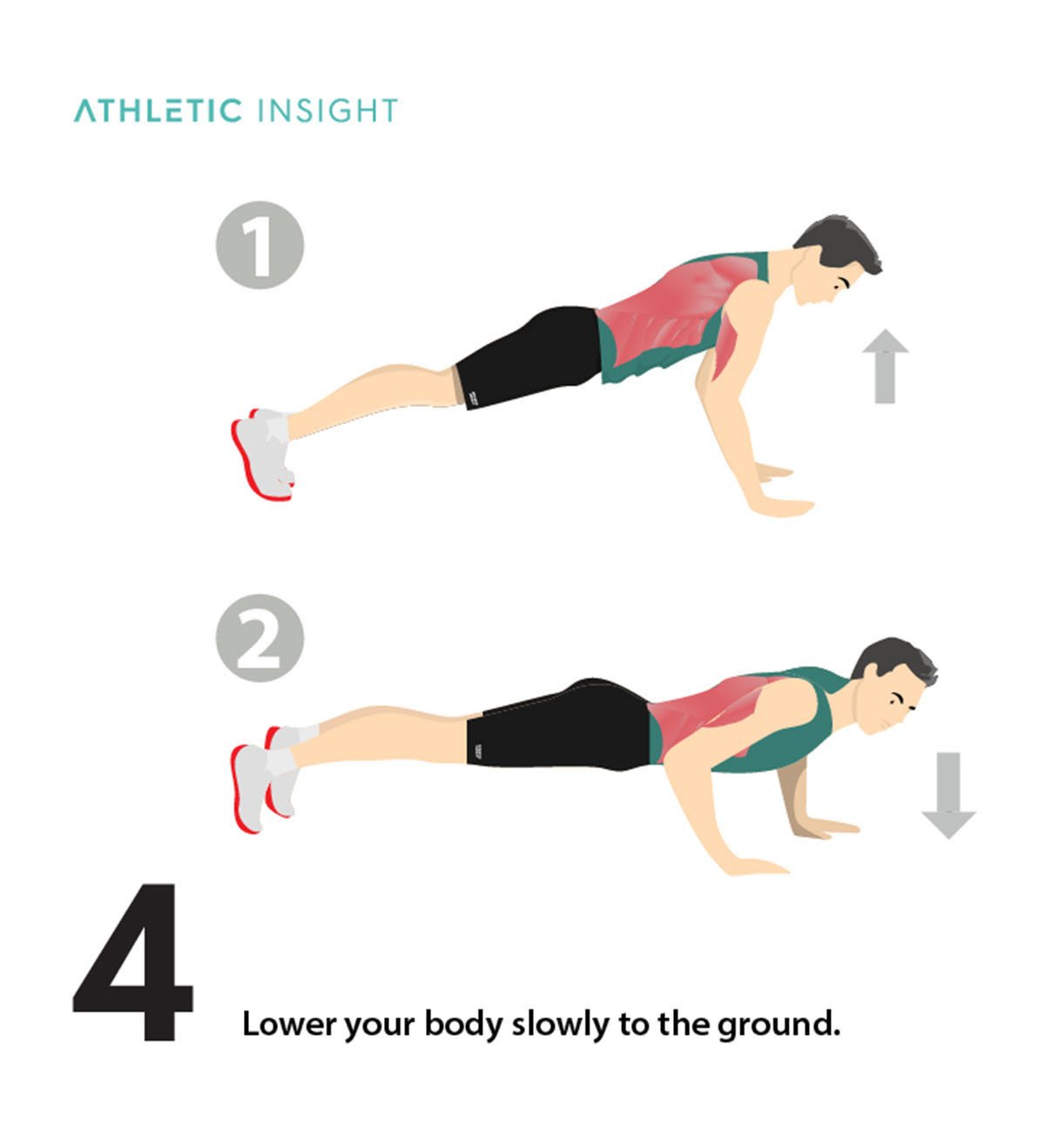
5. Pause for a second before pressing off of the floor back to the starting position
To bring yourself back up into the plank position, squeeze your chest and push back up. Your elbows will straighten. During this, exhale. The power comes from your core, chest, back, and arms. Engage your hands by drawing up. Push-ups will enhance your grip strength if done correctly.
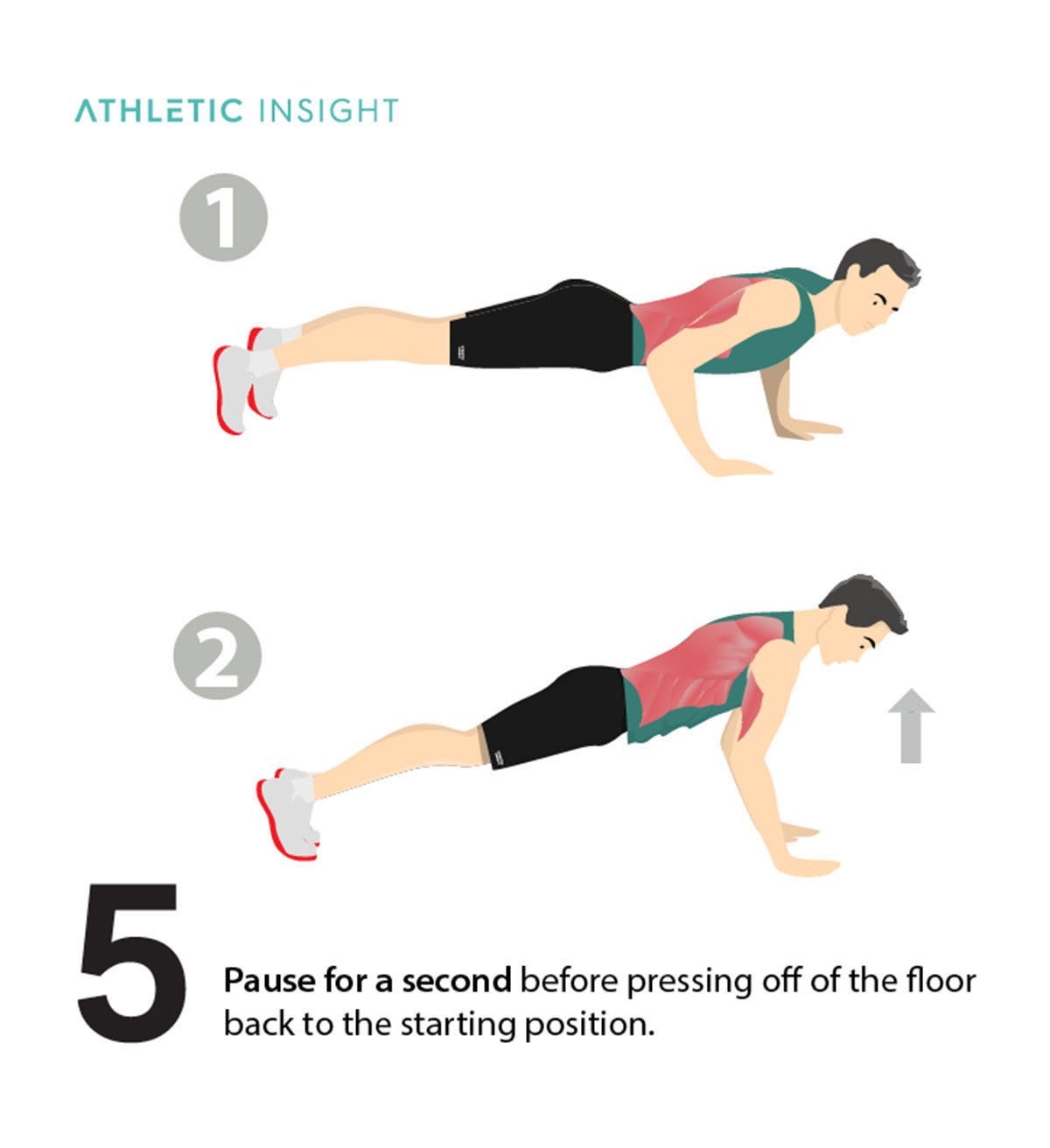
You will want to make sure that your muscles are engaged and squeezed throughout the movement. Push-ups are supposed to make you strong, so fully utilize your strength and gain all that you can out of this exercise.
When you are exercising, your heart and lungs deliver oxygen-rich blood to the muscles you are using. This is why it is essential to continue breathing throughout your workout.
Make sure to inhale while lowering your body and exhale while lifting yourself. It is common to hold your breath or forget to breathe while exerting yourself. Not breathing during exercise will risk having muscle cramps, becoming dizzy, or developing a hernia.
What are the Phases of Conventional Push-up?
Not everyone can do a conventional push-up right away. It is essential to understand the components of push-ups and how to train your body to perform the exercise successfully.
A conventional push-up is the most common form of this exercise. This is when you support your body weight with your hands and feet, keeping your legs and back straight so that your body is in a straight line. You lower yourself to the ground and push yourself back up.
This maneuver may be difficult for beginners or for those who have not built up the necessary strength to complete a push-up. To dominate push-ups, you must train your body using these phases.
1. Teach the Push-up to your muscles.
Do this by practicing each part of the exercise. Practice holding yourself in a plank position, and practice the push-up motion using other variations until you can complete a conventional push-up.
2. Train the body for working out with body weight.
You can do push-ups against a wall, on your knees, or using elevation.
3. Build up your strength to perform Push-ups.
Increase your core, arm, and back strength by practicing push-ups and by doing other exercises.
What are the Mistakes for Push-up form?
There are possible mistakes one can make with their push-up form. It is imperative to use the perfect push-up form when exercising, or else you may end up injured, or the exercise will not be as effective as intended.
The main push-up mistakes involve hand and arm placement. If your hand position is too broad, your elbows will flare out instead of correctly lining up with your body. This can lead to a limited range of motion, shoulder injuries, and a less effective workout for your chest.
To prevent this mistake, use you must use the correct push-up form. This means positioning your grip around shoulder-width and ensuring that your elbows align with your chest.
Another hand position mistake during push-ups is turning your hands in slightly. This risks shoulder impingement or Swimmer’s Shoulder. In proper form, the hands should be facing forward.
Another common push-up mistake is “shrugging” or letting the shoulders drift up towards the head. This occurs when you are fatigued, as your body is trying to redistribute some of the pressure from the exercise.
Instead, pull your shoulders down and make sure to hold them in a natural position and engage the muscles surrounding them. Most push-up mistakes can be avoided by using proper form and focusing on engaging your muscles. This is important to make sure you get the most out of your exercise.
How to Determine Proper Rep for Push-up?
In strength training, the word “reps” refers to how many times you complete an exercise before taking a break or stopping, also known as repetitions. There are easy ways to calculate how many reps you should do when performing push-ups.

One method is to do as many push-ups with proper form as you can until you cannot complete anymore. Most trainers would recommend you push yourself to do one more push-up before you stop, for maximum strength training effect.
Another method is to time yourself. Do as many push-ups as you can manage in two minutes. Take the result and divide it by three. This is how many repetitions you should do before resting.
There are also standard rep guidelines you can follow. For example, start with three sets of ten repetitions. If you find this is too easy, increase the number of reps.
Which Muscles are Involved while Performing Push-up?
The muscles involved in a push-up are the following.
- The pectorals, or chest muscles.
- The triceps or upper arms.
- The anterior deltoid, or front shoulder muscles.
- The rest of the deltoid muscle group.
- The serratus anterior, or the muscles at the sides of the chest.
- Abdominal muscles
- The back muscles.
- Other arm and midsection muscles
The pectorals, deltoids, and triceps gain improved endurance and strength. The use of the abdominal muscles strengthens the lower back and core. When the upper-body and arm muscles are properly engaged, they become stronger.
How to do a Push-up?
To dominate push-ups, make sure to follow the proper steps.
- Get into an upward position, hands on the floor and shoulder width apart.
- Keep abs tight and your whole body in a straight line.
- Keep your neck relaxed and head neutral.
- Lower your body slowly to the ground
- Pause for a second before pressing off of the floor back to the starting position.
What are the Push-up Challenges?
A push-up challenge is a specific exercise or group of exercises designed to challenge you or enhance your push-ups.
Three common push-up challenges are the following.
- 100-Rep Push-Up Challenge.
- Push-Up Strength EMOM.
- Push-Up HIIT.
What are the Push-up Variations?
There are many variations of push-ups besides conventional push-ups. A variation is any push-up besides the previously described conventional ones.

- Wide Hands Push-Up
- Military (Strict) Push-Up
- Diamond (Triangle) Push-Up
- Hindu Push-Up
- Pike Push-Up
- Cross-Body Push-Up
- Sphinx Push-Up (Triceps Extension)
- Spiderman (Side Kick) Push-Up
- One-Arm Push-Up
- Staggered Hands Push-Up
- Power and Clap Push-Up
- Flying Push-Up
- Archer Push-Up
- Push-Up On Your Knees
- Incline Push-Up
- Feet Stacked Push-Up
- Decline Push-Up
- Weighted Push-Up
- Eccentric Push-Up
These push-up variations can make push-ups easier or more challenging or can target specific muscle groups, depending on your goals.
What is the Necessary Equipment for Push-up?
You can perform push-ups without any equipment. However, one can use a 5” foam block to make push-ups more challenging and train the body to perform deeper push-ups.
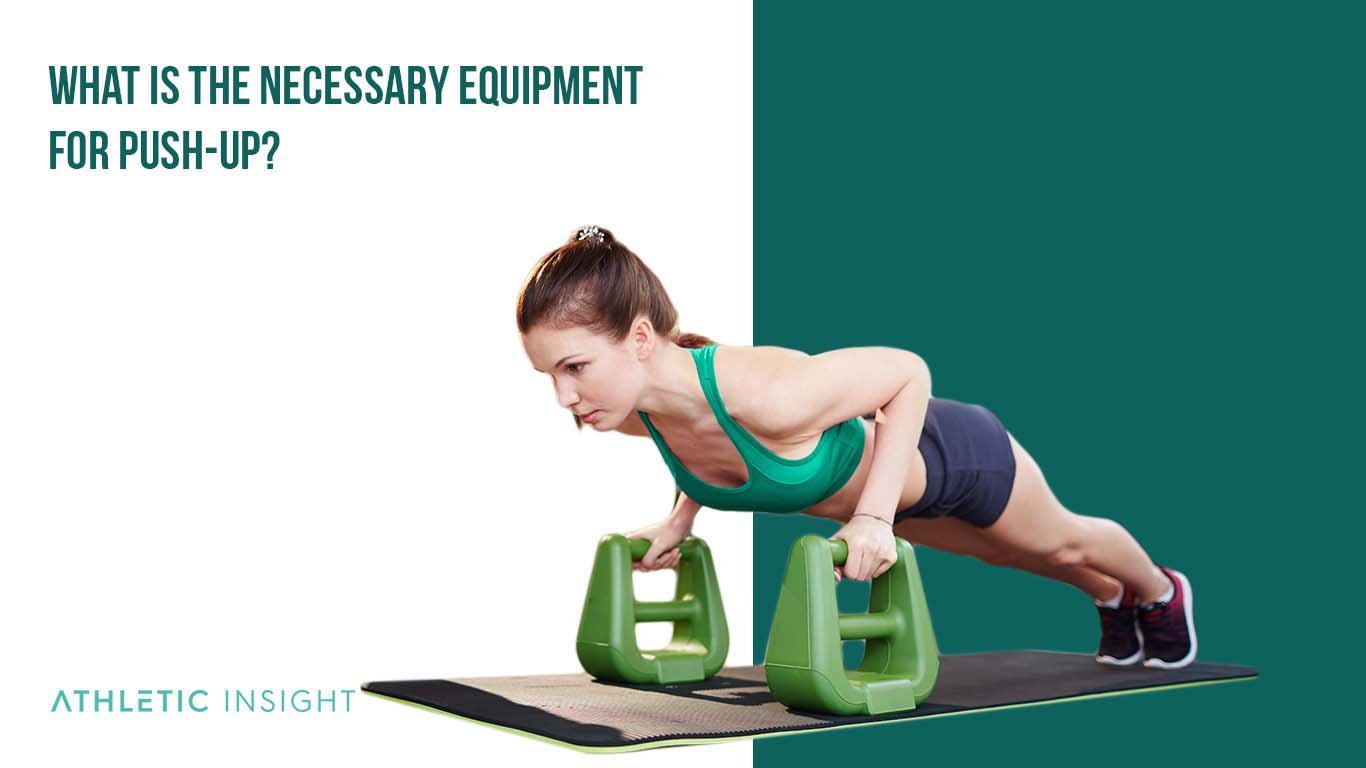
What are the World Records for Push-ups?
An official entity must approve each push-up world record attempt. This entity is usually the Guinness World Record organization.
To set or break a record, you must follow strict guidelines to collect and submit evidence of your world record attempt.
There are many push-up-related records, such as most push-ups in 24 hours, most consecutive push-ups, most push-ups in one hour, and more. Guinness often separates record categories by sex.
For example, Paddy Doyle was the male who completed the most push-ups in 12 hours by performing 19,325 on May 1, 1989. Doyle also is said to hold the record for most push-ups in one year.
There is no 12-hour female record, but Eva Clarke set a record in 2014 for the most knuckle push-ups in 24 hours. She performed 9,241 of this challenging variation.
What are the Push-up Related Facts?
There are some significant facts related to push-ups, this includes hormone changes, testosterone levels, mood changes, and where else the push-up is utilized.
Does the Push-up Affect the Hormones?
Push-ups can affect your hormone levels, just like any physical activity or exercise. Exercise impacts testosterone and growth hormone levels the most.
Growth hormones help to build and repair tissue. It affects your muscle mass and metabolism, along with helping to burn fat.
Does the Push-up Increase Testosterone?
Yes, push-ups increase testosterone levels. Testosterone is a male steroid hormone. Both sexes produce testosterone, however. Exercise, particularly resistance exercises, raises testosterone levels.
Does the Push-up Affect the Mood?
Push-ups, like all exercises, affect the brain’s dopamine and serotonin levels. It reduces cortisol (or stress hormone) levels. Frequent and consistent exercise has proven to improve one’s mood overall and decrease the chances of Major Depressive Disorder.
Is the Push-up Practiced within CrossFit?
Yes, CrossFit uses push-ups. CrossFit uses different variations of push-ups depending on the desired result.
Is the Push-up a Military Movement?
Yes, push-ups are a military movement. This compound exercise is essential for a member of the military. A military push-up is a specific, strict variation where you tuck your elbows and narrow your hand spacing.
Is the Push-up Essential?
Yes, push-ups are essential for individuals who want to build upper body strength. While there are other ways to build back, arm, shoulder, and core strength, push-ups are one of the most efficient and simple ways to do this.
Is the Push-up a Compound Exercise?
Yes, push-ups are an example of a compound exercise. Compound exercises are exercises that work out more than one muscle group simultaneously.
The benefits of performing compound exercises are calorie burning and more efficient strength training. You will gain more muscle mass quicker than if you were performing simple exercises that only work one muscle group at a time.
Your heart rate also improves, as your heart has to work harder to deliver oxygen to the blood in multiple muscle groups. This elevation is good for your heart health and calorie and fat burning. Elevating your heart rate during exercise helps you lose weight and maintain excellent health.
Push-ups are a compound exercise because they work out your back, chest, shoulders, triceps, abs, and legs together.

